We have all been anxious and went mad when a white coat person came up with a needle in his hand specifically in our childhood, because those were the days with maximum injections penetrated no matter for what reason.
And now in the stage of adulthood, we still hesitate to decide whether to get injected or have pills, cause it really hurts.
As per the latest development in medical sector based on nanotechnology, researcher named Mark Kendall from University of Queensland invented a chip-like structured patch with microscopic spikes dry coated with vaccines which identifies the presence of disease after penetrating the nanopatch in stratum corneum and through epidermis and dermis (skin layers of human body) based on proteins flowing in blood without even feeling the pain.
The chips of the nanopatch are made up of the gold coated silicon. Later when the development of the prototype will be commercially started, the tiny wafer chips will be replaced by plastic or polymer material to reduce the manufacturing cost, said Corrie one of the researcher in University of Queensland.

Major advantage of known nanopatch technology is the reduced analysis time utilized to detect diseases in laboratories. Compared to various other vaccines and medication equipment, it does not require any kind of cold storage to retain its durability.
Due to this revolutionary invention, the traditional method of using needles since last 166 years in order to collect the blood samples to examine the disease and to inject the drug to control or prevent the symptoms may soon come to an end.
Kendall said, “An invention which started as a doodle would now take a decade to hit the market”.
Researchers have developed this nanopatch with a motive to diagnose diseases like malaria, tuberculosis, and other infectious disease, due to widespread influence of this disease in remote areas where there are no facilities to draw blood and examine it.

At initial stage, the test was conducted on mice in laboratories and the results were fruitful . Further as a next step towards the research, Kendall and his team are now doing nanopatch medical trials on human volunteers in Brisbane.
Kendall said, “The outlook of creating incredible which would really make difference to millions of people gives a wonderful feeling”.
The team is also curiously working on similar nanopatch development prototypes in terms of replacing insulin syringes for diabetic patients and also predicted that they will start the clinical trials in coming years.
Best part is the overall research ensures to deliver injection-free test and vaccination process in future.
